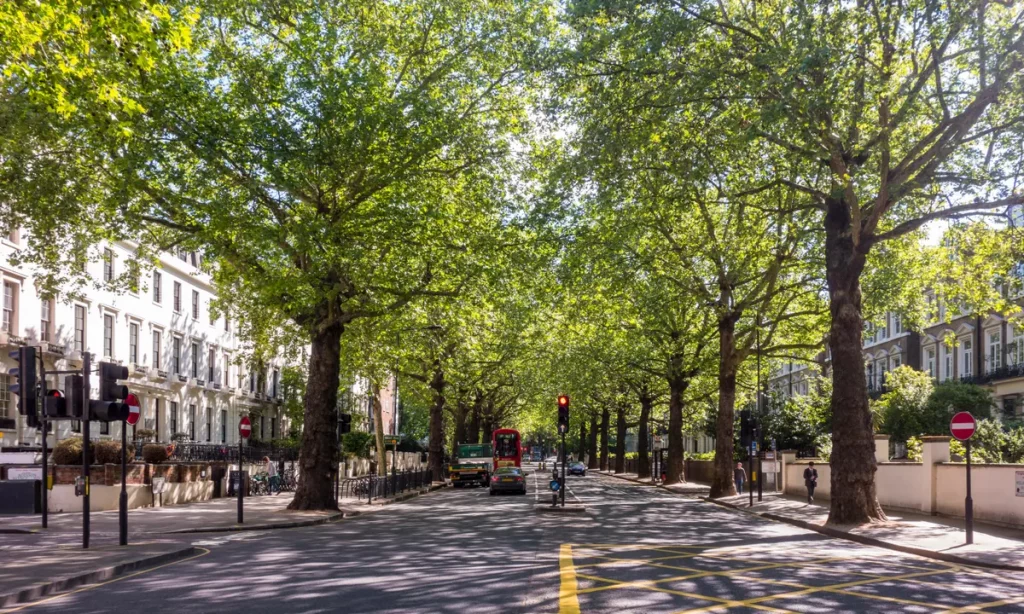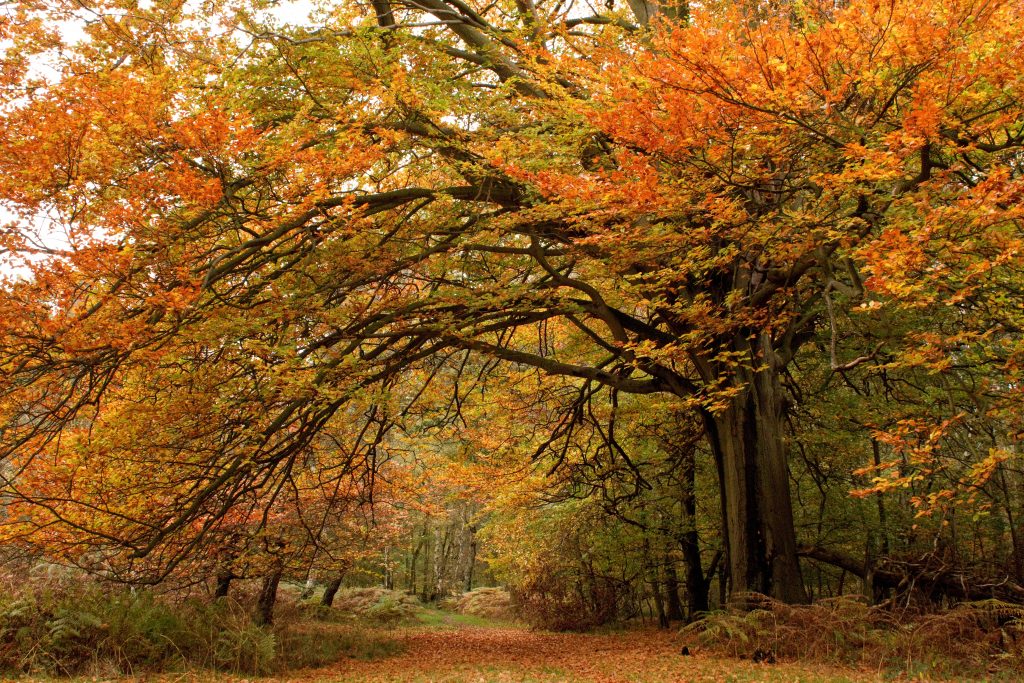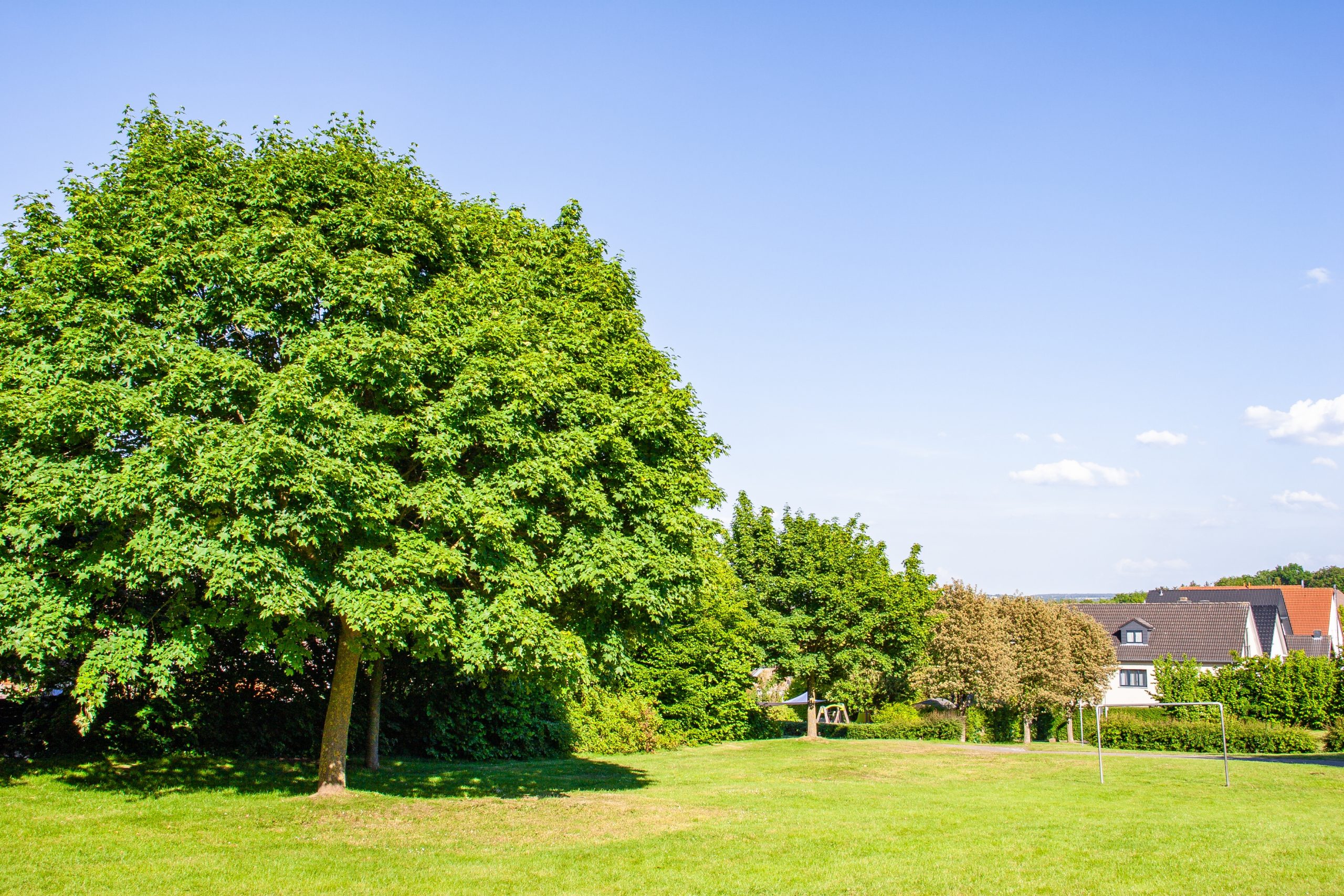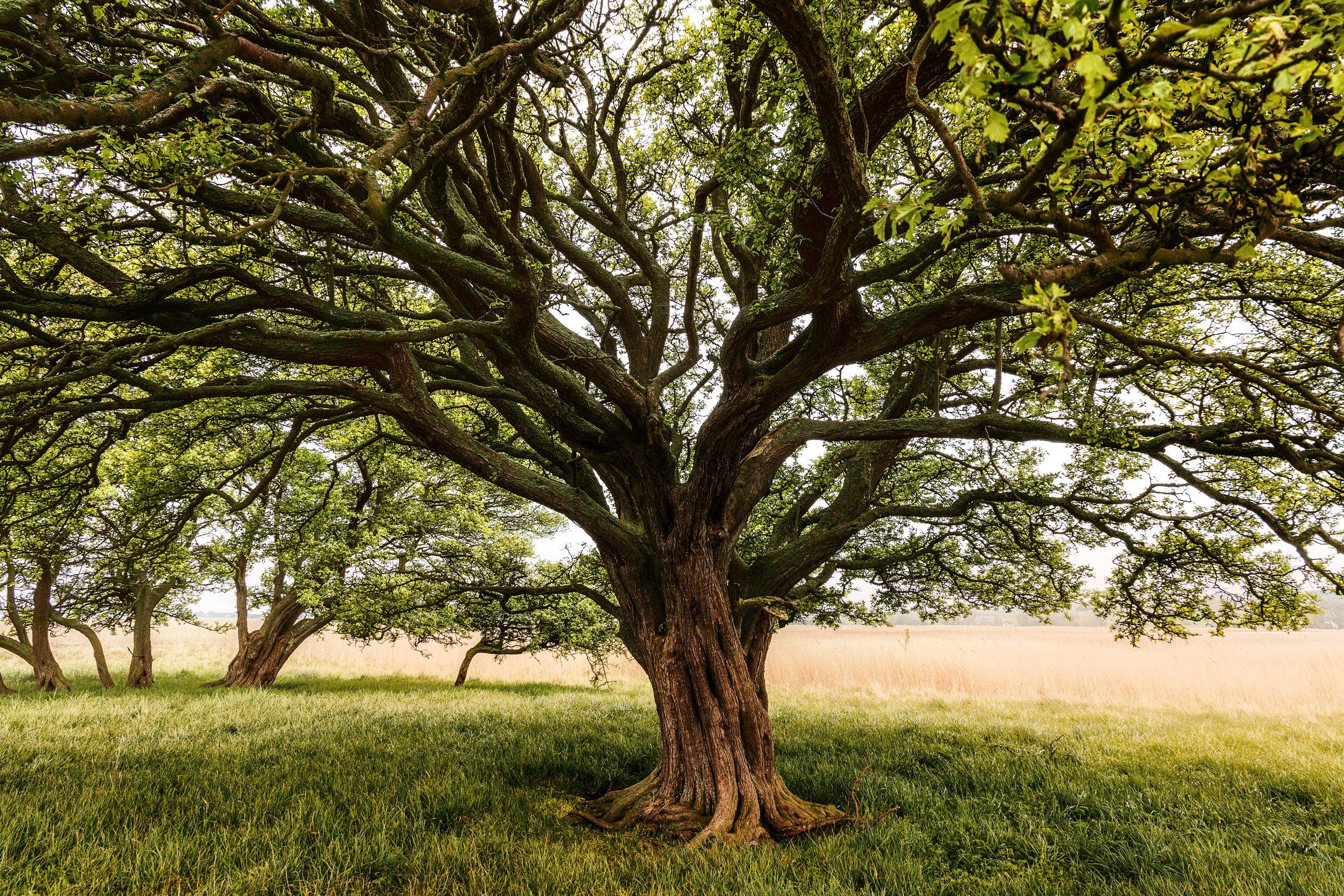THE SCIENCE BEHIND HOW TREES PROVIDE OXYGEN
THE SCIENCE BEHIND HOW TREES PROVIDE OXYGEN
The significance of trees in producing oxygen for the planet cannot be overstated. Trees are vital to life on Earth, and their role in generating oxygen has far-reaching implications for the planet’s ecosystems and the well-being of all living organisms. Here’s why trees’ oxygen production is so crucial:
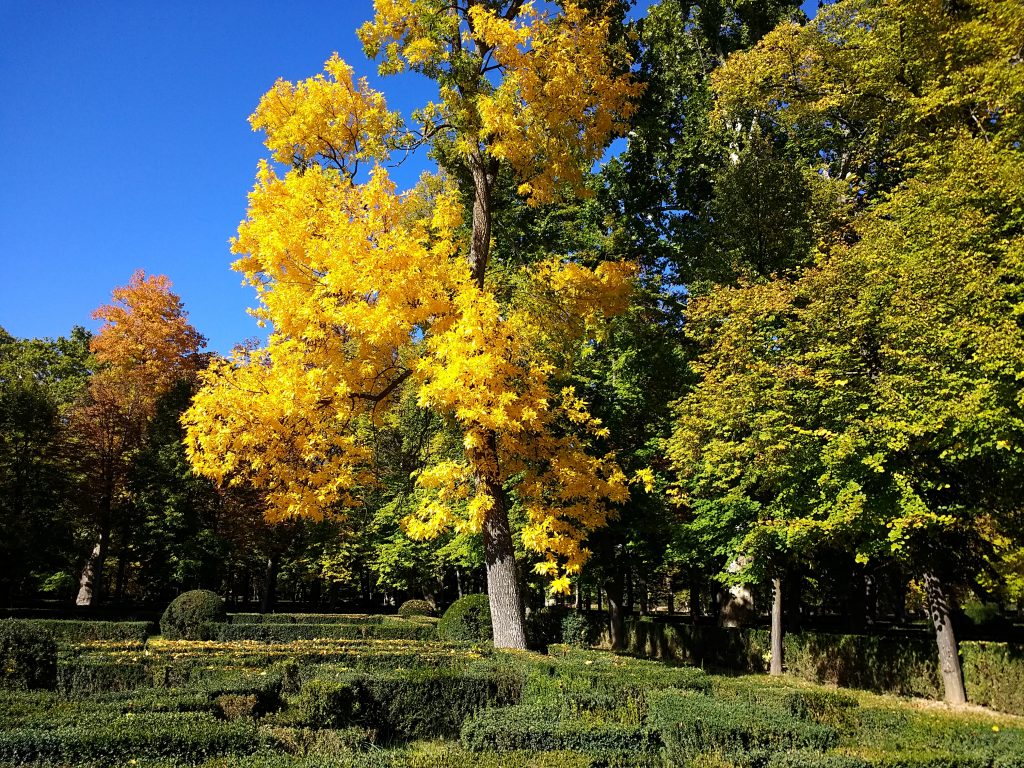
- Oxygen Generation: Trees are one of the Earth’s primary sources of oxygen. Through the process of photosynthesis, trees convert carbon dioxide (CO2) and water (H2O) into oxygen (O2) and glucose (C6H12O6) using sunlight as an energy source. This oxygen production is essential for the respiration of all aerobic organisms, including humans.
- Supporting Human Life: The oxygen we breathe is essential for human survival. Oxygen enables the process of cellular respiration, providing the energy needed for bodily functions. Healthy oxygen levels in the atmosphere are crucial for human health and well-being.
- Balancing the Atmosphere: Oxygen is a fundamental component of Earth’s atmosphere, making up approximately 21% of the air we breathe. Maintaining this balance is essential for the overall stability of our planet’s atmosphere and climate.
- Mitigating Air Pollution: Trees play a significant role in purifying the air. They absorb harmful pollutants like CO2, sulfur dioxide (SO2), and nitrogen oxides (NOx) during photosynthesis, which helps improve air quality and reduce the negative effects of air pollution.
- Carbon Sequestration: Trees store carbon in their biomass, including leaves, branches, and trunks. This carbon sequestration helps mitigate the greenhouse effect by removing CO2 from the atmosphere, thereby slowing the pace of climate change.
- Biodiversity and Ecosystem Health: Forests and woodlands support a wide range of plant and animal species. The oxygen produced by trees supports the diverse life forms found in these ecosystems. Additionally, healthy ecosystems contribute to oxygen production by maintaining the overall health of trees.
- Soil Health: Oxygen released through tree roots helps improve soil aeration, allowing for better water infiltration and nutrient absorption. This benefits the health of plants, including the trees themselves, and supports the overall ecosystem.
- Medicinal and Economic Benefits: Trees provide numerous ecosystem services, including medicinal benefits. Many plant-derived medicines are sourced from trees. Furthermore, trees are essential for various industries, including forestry, agriculture, and tourism, contributing to the global economy.
- Resilience to Natural Disasters: Forested areas, including trees, can help mitigate the impacts of natural disasters like floods, landslides, and hurricanes. Their root systems stabilize soil, reduce erosion, and act as windbreaks, protecting communities and ecosystems.
- Cultural and Recreational Value: Trees hold cultural significance for many societies and provide recreational opportunities. Parks and green spaces with trees offer places for relaxation, outdoor activities, and natural beauty.
In summary, trees are Earth’s oxygen factories, producing the life-sustaining gas that supports the respiration of all aerobic organisms. Their significance extends beyond oxygen production to include carbon sequestration, air and water purification, and ecosystem health. Preserving and responsibly managing trees are critical for maintaining a healthy planet and ensuring a stable supply of oxygen for generations to come.
Photosynthesis process as the primary mechanism by which trees generate oxygen.
Photosynthesis is the primary mechanism by which trees generate oxygen. This vital biological process occurs in the chloroplasts of plant cells, particularly in the green pigment chlorophyll. Here’s a step-by-step explanation of the photosynthesis process in trees:
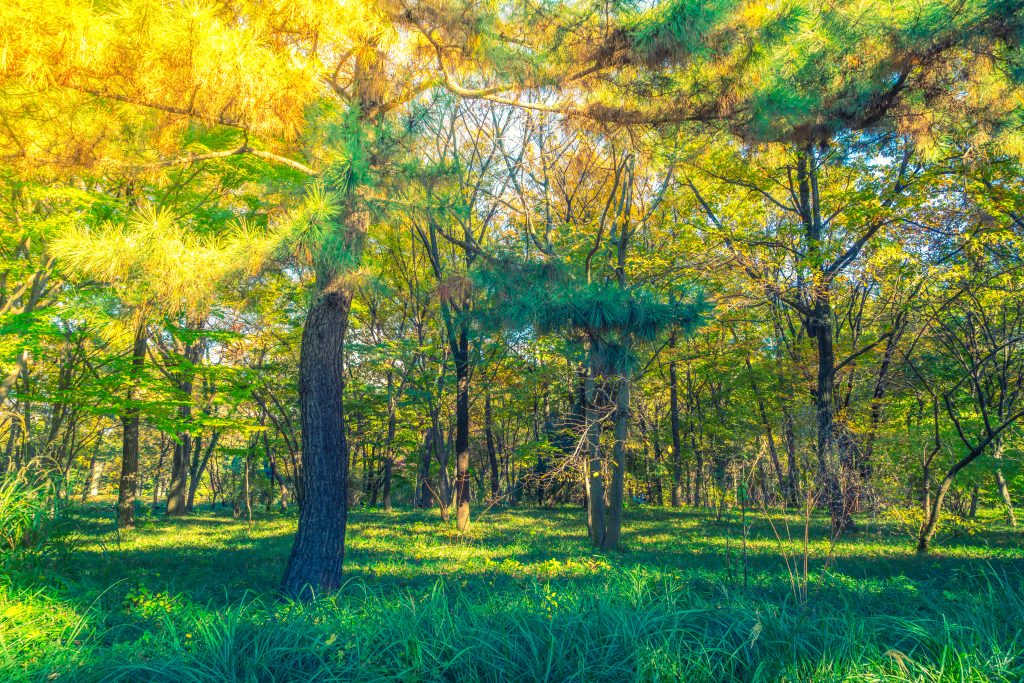
- Absorption of Sunlight: Trees have specialized cells in their leaves, called chloroplasts, which contain the pigment chlorophyll. Chlorophyll absorbs sunlight, primarily in the blue and red parts of the electromagnetic spectrum.
- Light-Dependent Reactions: A. During the first stage, called the light-dependent reactions, chlorophyll molecules capture photons (light energy) from the sun. B. This captured energy splits water molecules (H2O) into oxygen (O2) and protons (H+). This process is known as photolysis. C. The released oxygen atoms combine to form diatomic oxygen gas (O2), which is released into the atmosphere as a byproduct.
- Electron Transport Chain: A. The energy from sunlight also drives the movement of electrons along a chain of proteins embedded in the thylakoid membrane of the chloroplasts. B. As electrons move through this chain, they release energy that is used to pump protons (H+) into the thylakoid space.
- ATP and NADPH Formation: A. The proton concentration in the thylakoid space creates a proton gradient, and protons flow back into the stroma of the chloroplast through ATP synthase. B. This flow of protons generates adenosine triphosphate (ATP), which stores energy, and nicotinamide adenine dinucleotide phosphate (NADPH), an electron carrier.
- Carbon Fixation (Calvin Cycle): A. In the second stage of photosynthesis, known as the Calvin cycle, ATP and NADPH produced during the light-dependent reactions are used to convert carbon dioxide (CO2) into glucose (C6H12O6). B. This process involves a series of enzyme-driven reactions that ultimately produce glucose, a sugar that stores chemical energy.
- Oxygen Release: A. While glucose is the primary product of photosynthesis, a significant byproduct is oxygen (O2). B. The oxygen atoms generated during the light-dependent reactions combine to form diatomic oxygen gas (O2), which is released through small openings called stomata on the tree’s leaves and stems.
- Glucose Production: A. Glucose is used by the tree as an energy source for growth, maintenance, and reproduction. B. Some glucose is also stored as starch in various parts of the tree, serving as an energy reserve.
- Overall Reaction: The overall chemical equation for photosynthesis in trees can be summarized as follows: 6 CO2 + 6 H2O + light energy → C6H12O6 (glucose) + 6 O2
In summary, photosynthesis is the remarkable process through which trees and other plants harness sunlight to convert carbon dioxide and water into glucose and oxygen. Trees release oxygen as a vital byproduct, which is essential for the respiration of animals, including humans, and helps maintain the oxygen balance in Earth’s atmosphere. This process sustains life on our planet and underscores the critical role of trees in maintaining a healthy ecosystem.
Fundamental Process of Photosynthesis in Trees
The fundamental process of photosynthesis in trees is a complex biochemical pathway that allows these plants to convert sunlight, carbon dioxide (CO2), and water (H2O) into glucose (a form of stored energy) and oxygen (O2). Photosynthesis occurs primarily in the chloroplasts, specialized organelles within plant cells, and involves a series of interconnected reactions. Here’s a step-by-step explanation of the process:
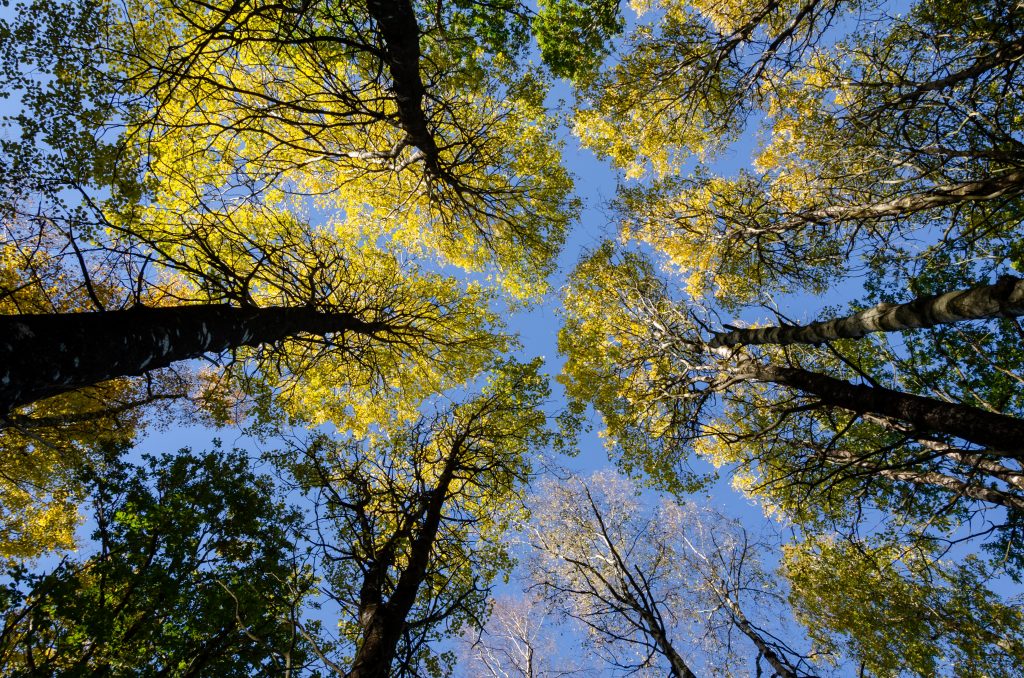
- Absorption of Sunlight:
- Photosynthesis begins when trees’ leaves, specifically the chloroplasts within leaf cells, capture sunlight using the green pigment chlorophyll. Chlorophyll is crucial for absorbing photons (light energy) from the sun.
- Light-Dependent Reactions:
- These initial reactions occur in the thylakoid membranes of the chloroplasts. They are called “light-dependent” because they require sunlight to proceed.
- Light energy is used to split water molecules (H2O) into oxygen (O2) and protons (H+). This process is known as photolysis. The chemical reaction can be represented as follows: 2 H2O + 2 photons → 4 H+ + 4 e- + O2
- The released oxygen atoms combine to form diatomic oxygen gas (O2), which is released into the atmosphere as a byproduct.
- The electrons (e-) produced during photolysis are used in subsequent reactions.
- Electron Transport Chain:
- The high-energy electrons released during photolysis move through a series of proteins embedded in the thylakoid membrane, collectively known as the electron transport chain (ETC).
- As electrons flow through the ETC, they release energy that is used to pump protons (H+) from the stroma (the fluid-filled space within the chloroplast) into the thylakoid space.
- ATP and NADPH Formation:
- The proton gradient created by the movement of protons into the thylakoid space generates a flow of protons back into the stroma through a protein complex called ATP synthase.
- This proton flow powers the synthesis of adenosine triphosphate (ATP), a molecule that stores energy.
- NADP+ (nicotinamide adenine dinucleotide phosphate) molecules pick up electrons and protons, forming NADPH, which serves as an electron carrier for later stages of photosynthesis.
- Carbon Fixation (Calvin Cycle):
- The Calvin cycle, which occurs in the stroma of the chloroplast, is the second stage of photosynthesis.
- ATP and NADPH produced during the light-dependent reactions are used to convert carbon dioxide (CO2) into glucose (C6H12O6) through a series of enzyme-driven reactions.
- Glucose, a sugar, is a primary product of photosynthesis and serves as an energy source for the tree.
- Oxygen Release:
- As a byproduct of the light-dependent reactions, oxygen atoms combine to form diatomic oxygen gas (O2).
- This O2 is released into the atmosphere through small openings called stomata on the tree’s leaves and stems.
- Glucose Production:
- Glucose produced during the Calvin cycle is used by the tree for energy, growth, and maintenance. Some glucose may also be stored as starch in various parts of the tree, serving as an energy reserve.
In summary, photosynthesis is the intricate process by which trees harness sunlight, water, and carbon dioxide to produce glucose and release oxygen. This process sustains the tree’s growth and health while also contributing to the oxygen balance in Earth’s atmosphere, making it essential for life on our planet.
If you need a tree service in Utah, you can call:
Truco Services, Inc.
4640 Commerce Drive
Murray, Utah 84107
(801) 466-8044
https://truetreeservices.com/
geocentric_weather id=”45ff4ccd-3d3f-498e-b0b9-91aaaf766bc4″]
About Murray, Utah
Murray is a city situated on the Wasatch Front in the core of Salt Lake Valley in the U.S. state of Utah. Named for territorial governor Eli Murray, it is the state's fourteenth largest city. According to the 2020 census, Murray had a population of 50,637. Murray shares borders with Taylorsville, Holladay, South Salt Lake and West Jordan, Utah. Once teeming with heavy industry, Murray's industrial sector now has little trace and has been replaced by major mercantile sectors. Known for its central location in Salt Lake County, Murray has been called the Hub of Salt Lake County. Unlike most of its neighboring communities, Murray operates its own police, fire, power, water, library, and parks and recreation departments and has its own school district. While maintaining many of its own services, Murray has one of the lowest city tax rates in the state.
Neighborhoods in Murray, Utah
Murray Oakes, Grant Park, Southwood Park, Murray Park, Murray Park Restrooms, Willow Pond Park, Neighborhood Veterinary Care
Things To Do in Murray, Utah
Bus Stops in Murray, Utah to Truco Services, Inc.
Bus Stop in Murray Central Station (Bay C) Murray, Utah to Truco Services, Inc.
Bus Stop in State St @ 4801 S Murray, Utah to Truco Services, Inc.
Bus Stop in Murray North Station Murray, Utah to Truco Services, Inc.
Bus Stop in State St @ 4949 S Murray, Utah to Truco Services, Inc.
Bus Stop in Murray Central Frontrunner/Trax Station Murray, Utah to Truco Services, Inc.
Bus Stop in Murray Blvd / Vine St (SB) Murray, Utah to Truco Services, Inc.
Bus Stop in State St @ 3925 S Murray, Utah to Truco Services, Inc.
Bus Stop in State St @ 4824 S Murray, Utah to Truco Services, Inc.
Bus Stop in State St @ 5223 S Murray, Utah to Truco Services, Inc.
Bus Stop in Murray Blvd / Allendale Dr (NB) Murray, Utah to Truco Services, Inc.
Bus Stop in Murray Blvd @ 5039 S Murray, Utah to Truco Services, Inc.
Bus Stop in State St @ 4721 S Murray, Utah to Truco Services, Inc.
Driving Directions in Murray, Utah to Truco Services, Inc.
Driving Directions from Woodruff Tree Trimming and Removal to 4640 Commerce Dr, Murray, UT 84107, USA
Driving Directions from Reliable Tree Care to 4640 Commerce Dr, Murray, UT 84107, USA
Driving Directions from Tree Pro-Tech to 4640 Commerce Dr, Murray, UT 84107, USA
Driving Directions from Prestige Tree And Landscape to 4640 Commerce Dr, Murray, UT 84107, USA
Driving Directions from Excellence Tree & Landscape to 4640 Commerce Dr, Murray, UT 84107, USA
Driving Directions from Amen Trees to 4640 Commerce Dr, Murray, UT 84107, USA
Driving Directions from Tim's Tree Care to 4640 Commerce Dr, Murray, UT 84107, USA
Driving Directions from Jordan Tree Service - Murray to 4640 Commerce Dr, Murray, UT 84107, USA
Driving Directions from Arbor Works to 4640 Commerce Dr, Murray, UT 84107, USA
Driving Directions from Diamond Tree Experts to 4640 Commerce Dr, Murray, UT 84107, USA
Driving Directions from Green Tree Arborist to 4640 Commerce Dr, Murray, UT 84107, USA
Driving Directions from TruCo Services to 4640 Commerce Dr, Murray, UT 84107, USA
Reviews for Truco Services, Inc. Murray, Utah
Emily Abercrombie
We had a great experience with TruCo! They were well priced, responsive and prompt. Michael was a pleasure to work with and gave us advice on which plants to put in where we took out our ugly old shrubs. I would highly recommend this company!!!
Michelle Turpin
TruCo Services gets 5 stars from us for customer service. We experienced a few issues with their services this last year and Rob Eccles in senior management, stepped in and immediately handled our issues. He was very committed to making sure they understood our expectations and would execute to make us happy.
Siobhan Billingsley
I work for a property management company and have the pleasure of working with Rob at a community in Sandy. He has been incredible to work with and always responds in a timely manner. He knows all the homeowners by name and address and is aware of all the "problem" areas when it comes to sprinklers. I never have to worry about following up with him because he always reaches out to provide me with an update. If you're looking to work with someone who takes pride in their job, is professional, and can solve the worst landscaping problems thrown your way, Rob is your guy. Thank you, Rob for all you do!
Jaime S.
We have used Truco at 2 of the complexes we manage, they have been great to work with. Good quality service, outstanding customer service with good communication. That's hard to find these days. I highly recommend them. Travis has been awesome to work with.
Jerusha Smart
We use TruCo for a majority of our properties and our home. While other landscaping companies we use come and go for various reasons like cost, communication issues, work performance, etc., TruCo is always consistent in price and work. Also, Rob is the best.


